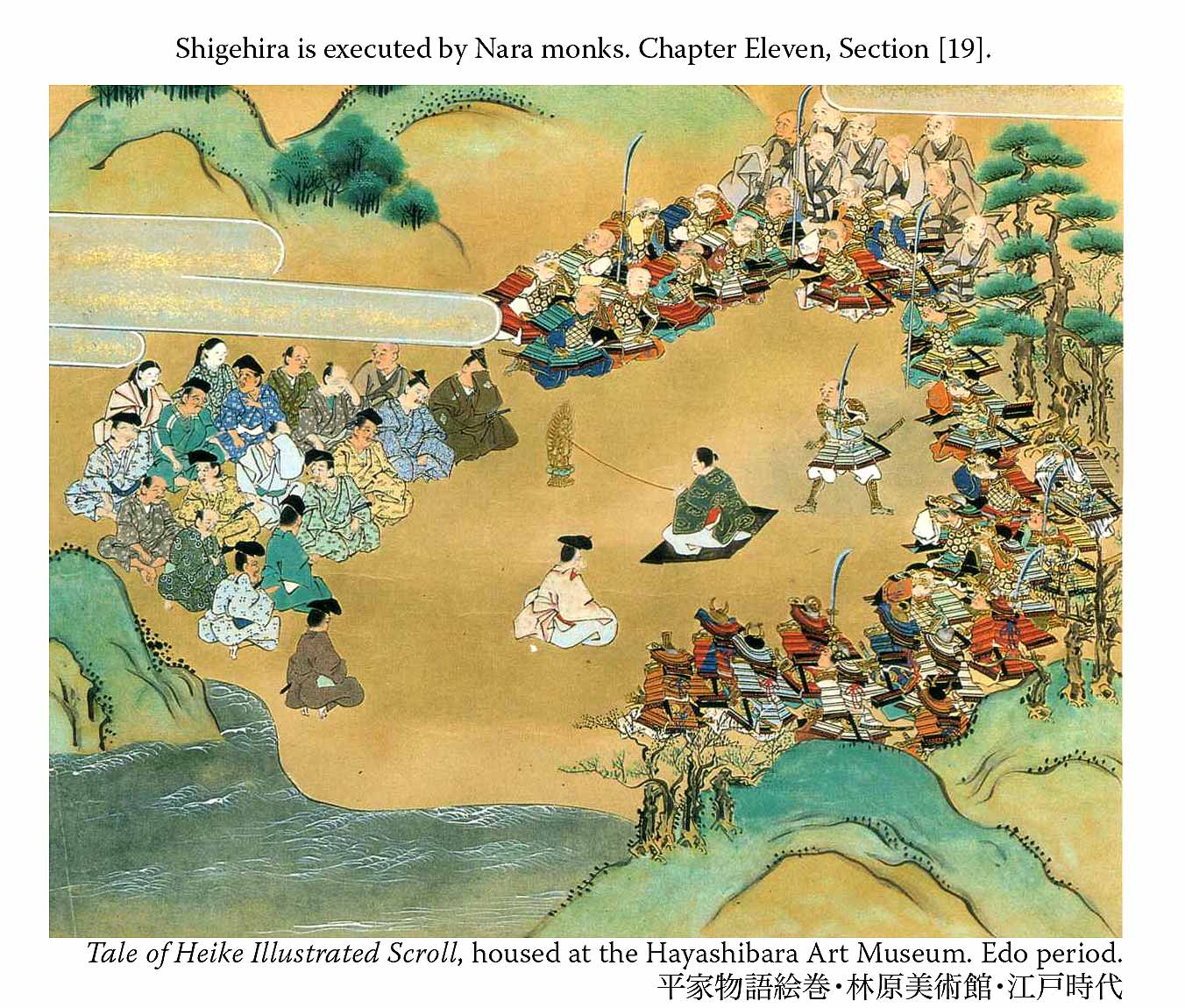Chapter 11 (Events of the first half of 1185)
Overview --- Yoshitsune participates in the critical victories for the Minamoto first at Yashima in Shikoku and then farther south near Kyûshû, at Dan-no-ura. Nevertheless, Yoritomo begins to doubt the loyalty of his brother. Both the Yashima and Dan-no-ura battles contain very famous scenes.
11-[1] Reverse Oars --- Yoshitsune, with the honor of an imperial edict of Go-Shirakawa, leaves Kyoto to attack the Taira at their stronghold at a place called Yashima. Before launching the boats for the crossing, Yoshitsune and Kagetoki argue about how to outfit the boats. Kagetoki wants them to be capable of quick retreat; Yoshitsune believes a warrior should think only of attacking. Kagetoki's intense jealousy of Yoshitsune will later cause him to slander Yoshitsune to Yoritomo and turn Yoritomo against his brother. However, for now, the crossing is made very rapidly and the Minamoto troops establish a beach landing.
- Kurô Tayû no Hôgan Yoshitsune is generally called in Japan just "Yoshitsune" and this is the name you will frequently see in stories other than The Tale of Heike. However, here and there this text refers to him as "Hôgan" or "Kurô"
- Kamakura Lord means Minamoto no Yoritomo, whose power base is in Kamakura near Edo (Tokyo) and where the military government will be established.
- Kenreimon'in and Nun of Second Rank, daughter and wife of Kiyomori. Kenreimon'in is also mother to the child emperor Antoku, who is with them.
- Kajiwara Kagetoki, a name to watch. It is the disagreement between him and Yoshitsune that, according to the Tale of Heike that is, leads to Yoshitsune's eventual fall from favor with his brother Yoritomo.
Section Summary
- Yoshitsune offers to Go-Shirakawa to vanquish all remaining Taira wherever they may be. He prepares to attack Yashima, where the Taira have made a stronghold.
- Kagetoki and Yoshitsune have sharp words over the tactics for a naval attack on Yashima. Kagetoki wants boats that can retreat quickly if necessary. Yoshitsune says a warrior should not think of retreat when going into battle.
- They make a rapid crossing, one that should take three days but is achieved in six hours because of the wind at their backs. The "three-day" count might seem excessive since the shore of Honshû is quite close to Shikoku. But they have left Honshû at a place not close to the Taira and they arrive at the east side of Shikoku for a rear-guard attack (Yashima is on the north shore of the island). It is lightly guarded.
Reading notes
- <358> "second year of Genryaku"---1185
Multimedia
Yoshitsune's attack on the Taira at Yashima
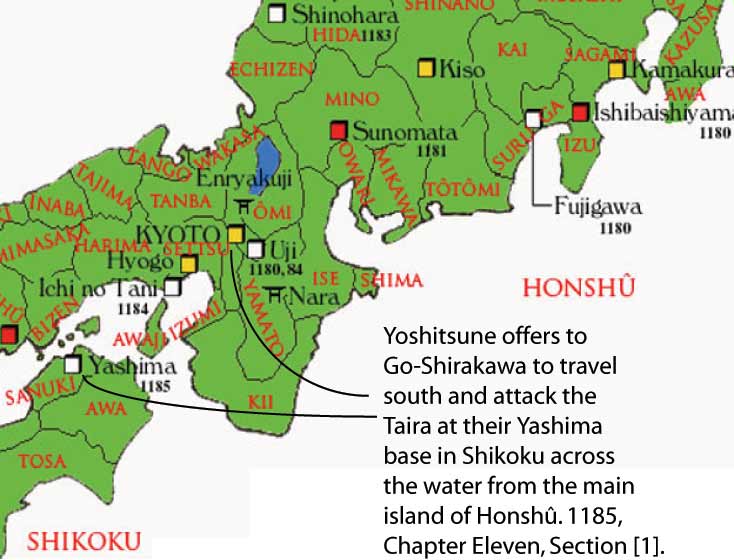
Yoshitsune's armor
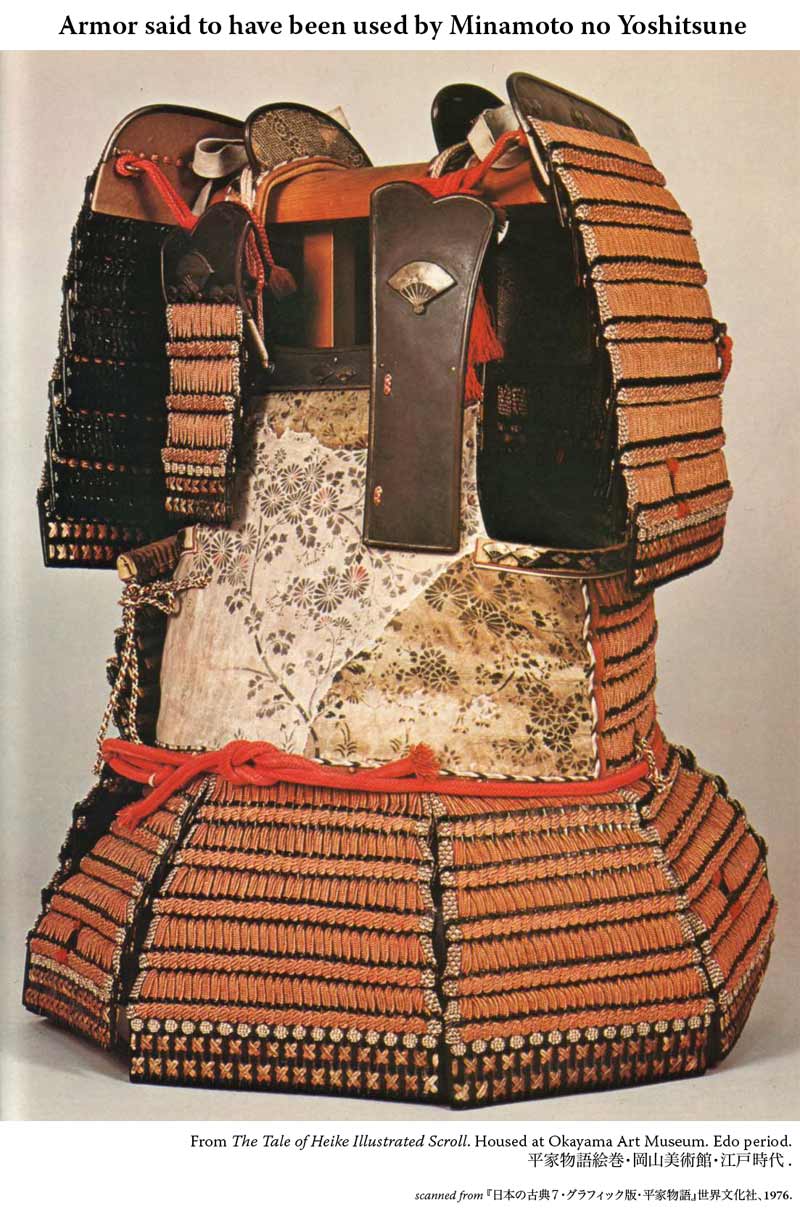
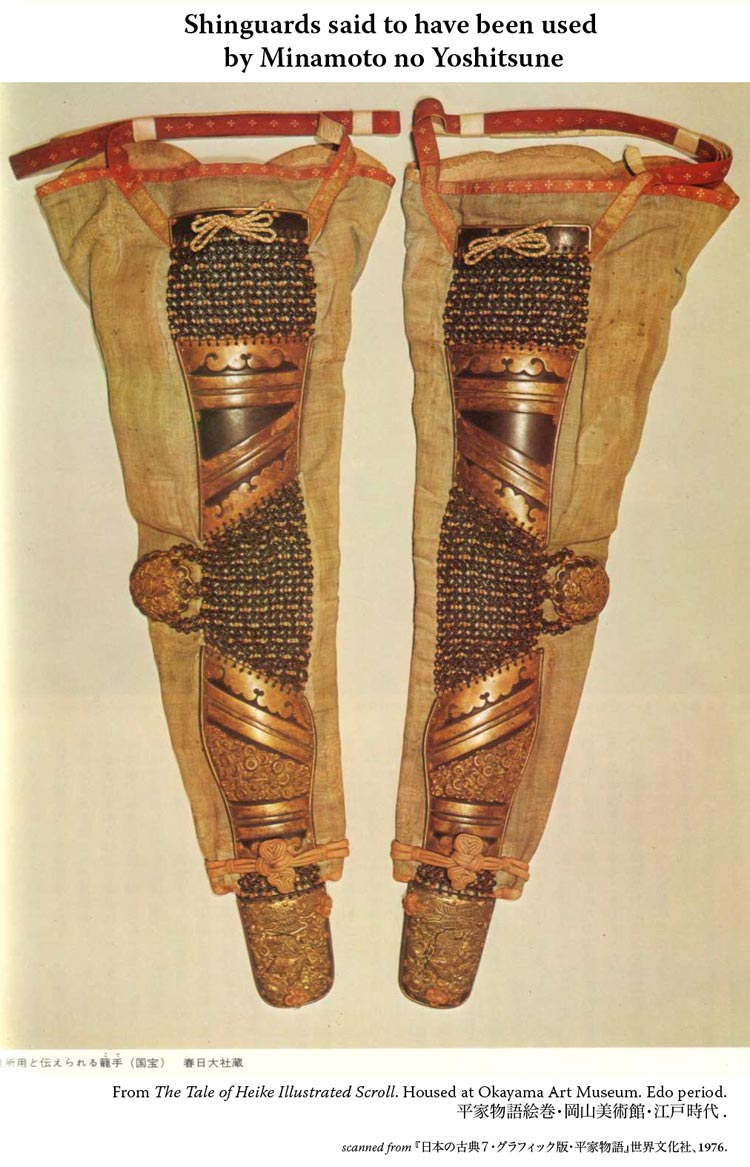
11-[2] Katsuura Beach and Ôzakagoe Pass --- Yoshitsune is delighted to make a successful beach landing at a place providentially called "Victory Beach." He quickly moved across Shikoku towards Yashima, traversing at night the mountain passes that separate him from his goal. They catch the Taira off-guard. The Taira take to their boats in a panic. Thus begins the battle at Yashima.
11-[3] The Death of Tsuginobu --- The battle at Yashima continues. Minamoto horses dash into the water towards the Taira who shoot arrows from boats towards them. The Taira offer a confused defense. One of the Minamoto warriors to fall is a man called Tsuginobu.
Multimedia
Minamoto forces (on the right, with white banners) charge off-shore towards the Taira who have panicked and boarded their boats at Yashima.
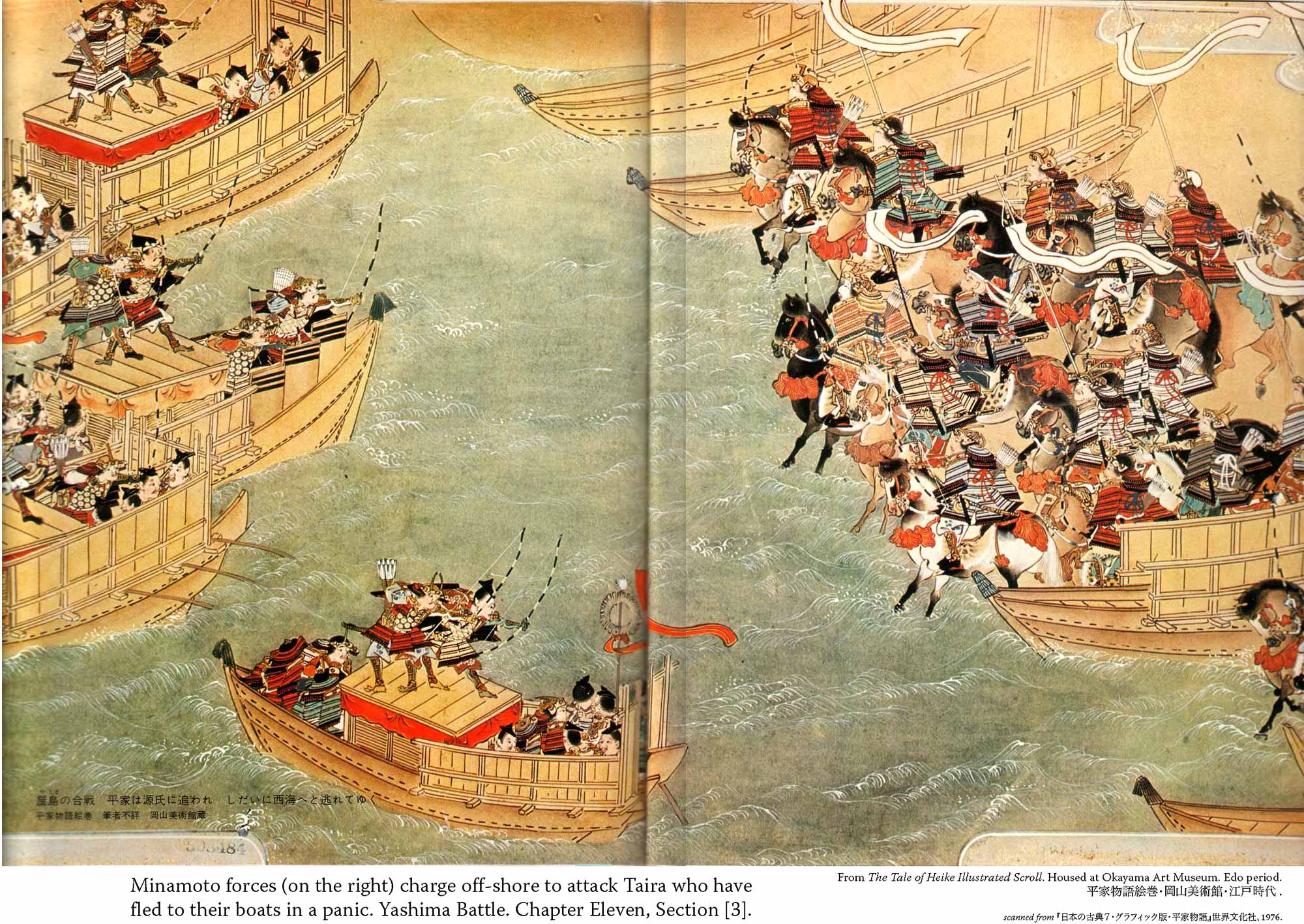
11-[4] Nasu no Yoichi --- The battle at Yashima continues. This is one of The Tale of Heike's most famous passages. A Minamoto archer named Nasu no Yoichi is commanded by Yoshitsune to accept the challenge of an off-shore target, a fan, that a Taira woman is holding out from the deck of a boat. Though it is 250 feet away, Nasu no Yoichi successfully strikes it. Both sides applaud his skill.
Character notes
- Munetaka is Yoichi Munetaka, son of Nasu no Tarô Suketaka of Shimotsuke. He is usually referred to as "Nasu no Yoichi" (Yoichi of the Nasu family).
Multimedia
Nasu no Yoichi hits the Taira target. This moment in the tale is also recited on an audio file on this web site elsewhere, with accompanying English text. Go here.
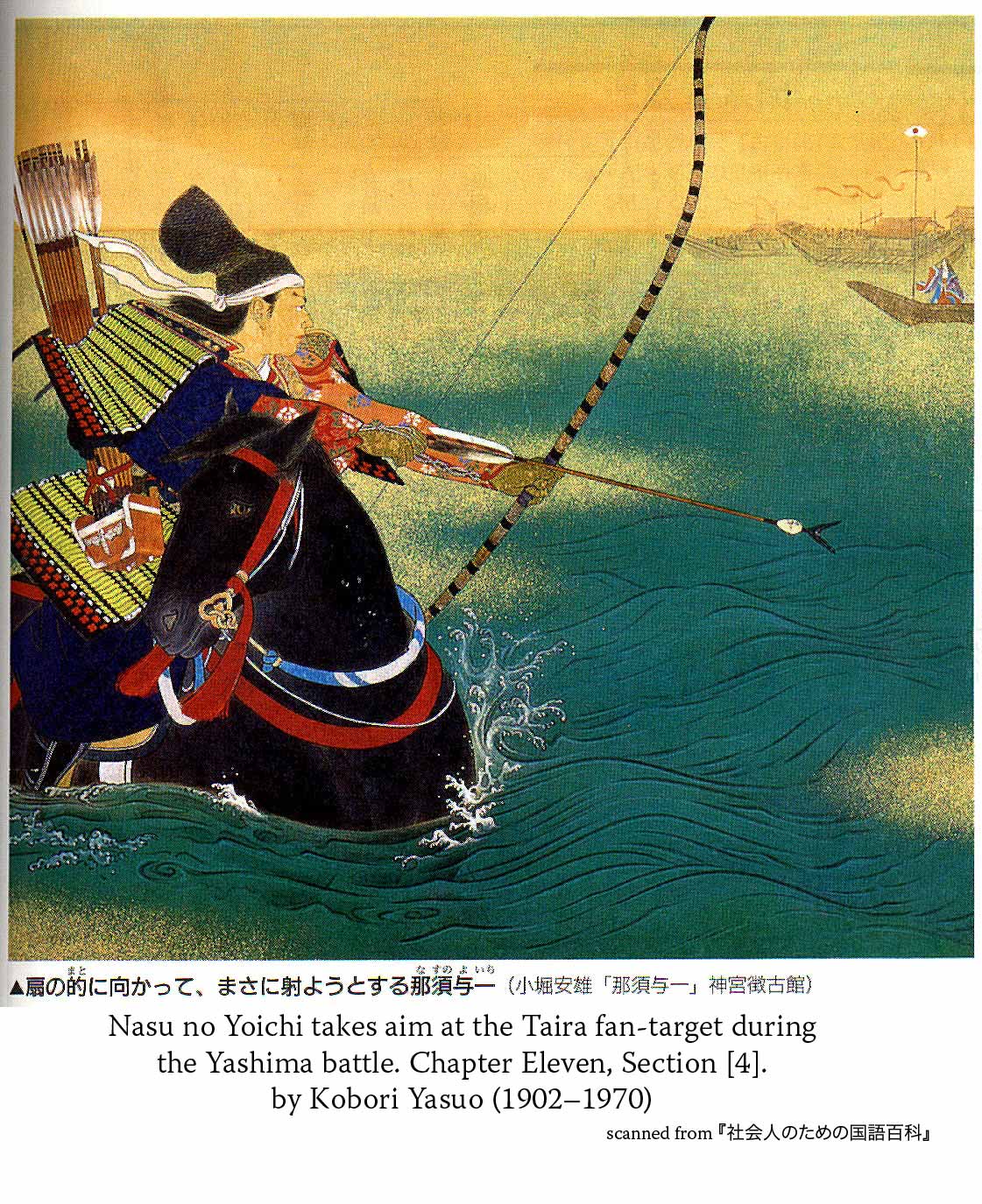
11-[5] The Dropped Bow --- The battle at Yashima continues. Yoichi shoots and kills, again by command, a Taira dancer who had come out from protection to celebrate the shot. As the text says, "some people praised the shot; others called it cruel." Evening-time fighting ensues. In the confusion of the mid-water fighting, a Minamoto warrior drops his bow into the sea. He risks his life to recover it. Other warriors think he is foolish until they hear him explain that it was a bow strung for weak archers and that if it had been found by the Taira it would have damaged Minamoto honor.
11-[6] The Battle at Shido --- The Taira retreat by boat from Yashima, first to a camp nearby in Shikoku called Shido. But Yoshitsune's pursuit forces them to leave Shikoku altogether. A ruse by Yoshitsune's man Yoshimori defeats a Taira general, Noriyoshi, and adds his leaderless men to Yoshitsune's. At last Kajiwara Kagetoki arrives at Yashima, but the Shikoku battles are entirely finished. (Yoshitsune had set out on the sixteenth, it is now the twenty-second of the month). Delayed by refitting his boats perhaps or by unfavorable winds perhaps --- I'm guessing here, the Japanese says they had "stayed behind" nokori-todomatta --- he has failed to show his military capabilities.
Character notes
11-[7] The Cockfights and the Battle at Dan-no-ura --- Yoshitsune joins forces with his brother Noriyori. (They had also fought together at Ichi-no-tani.) The Taira retreat to "Retreat Island" in Nagato province, to the south. This is near the crossing from Honshû to Kyûshû islands. The local warlord decides, based on a type of fortune-telling with fighting cocks, that he should support the Minamoto. Yoshitsune's forces outnumber the Taira three-to-one, and he prepares for the naval battle at Dan-no-ura, the last battle the Taira will fight. Before the battle Yoshitsune and Kagetoki almost come to blows. It is from this point that Kagetoki is "consumed by hatred of Yoshitsune." The battle begins with the Taira pressing an early advantage based on better strategy.
Character notes
- Kagesue (Kajiwara Genda Kagesue), was one of the anxious-to-fight warriors of Chapter Nine, Section [1] & [2] who received a fast horse from Yoritomo to attack Yoshinaka. He also fought bravely at ichi-no-tani. He is Kagetoki's heir.
- Kamakura Lord = Yoritomo
Multimedia
Location of Nagato province and Dan-no-ura
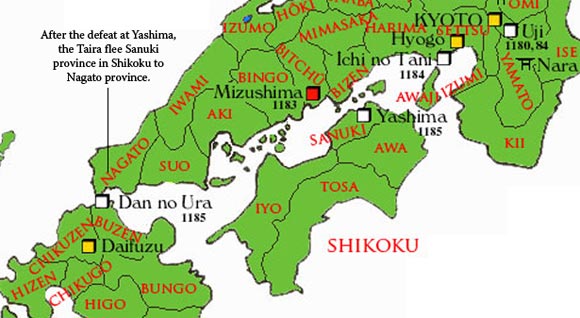
11-[8] Distant Arrows --- The battle of Dan-no-ura continues. From a great distant, some of the Minamoto and Taira test their archery skills against one another. Then chaotic battle breaks out. Heavenly omens indicate an imminent Minamoto victory.
Character notes
11-[9] The Drowning of the Former Emperor --- The battle of Dan-no-ura continues. This section is another of the most famous. I suppose some would say it is the single most famous moment. It also provides the wallpaper image that is on the web site, as some of you might have noticed. Taira must choose between capture and suicide by drowning. The Nun of Second Rank, Kiyomori's wife and grandmother to the eight-year-old emperor Antoku, leaps to her drowning, with the boy in her arms.
Multimedia
Portrait of Emperor Antoku at Sennyûji
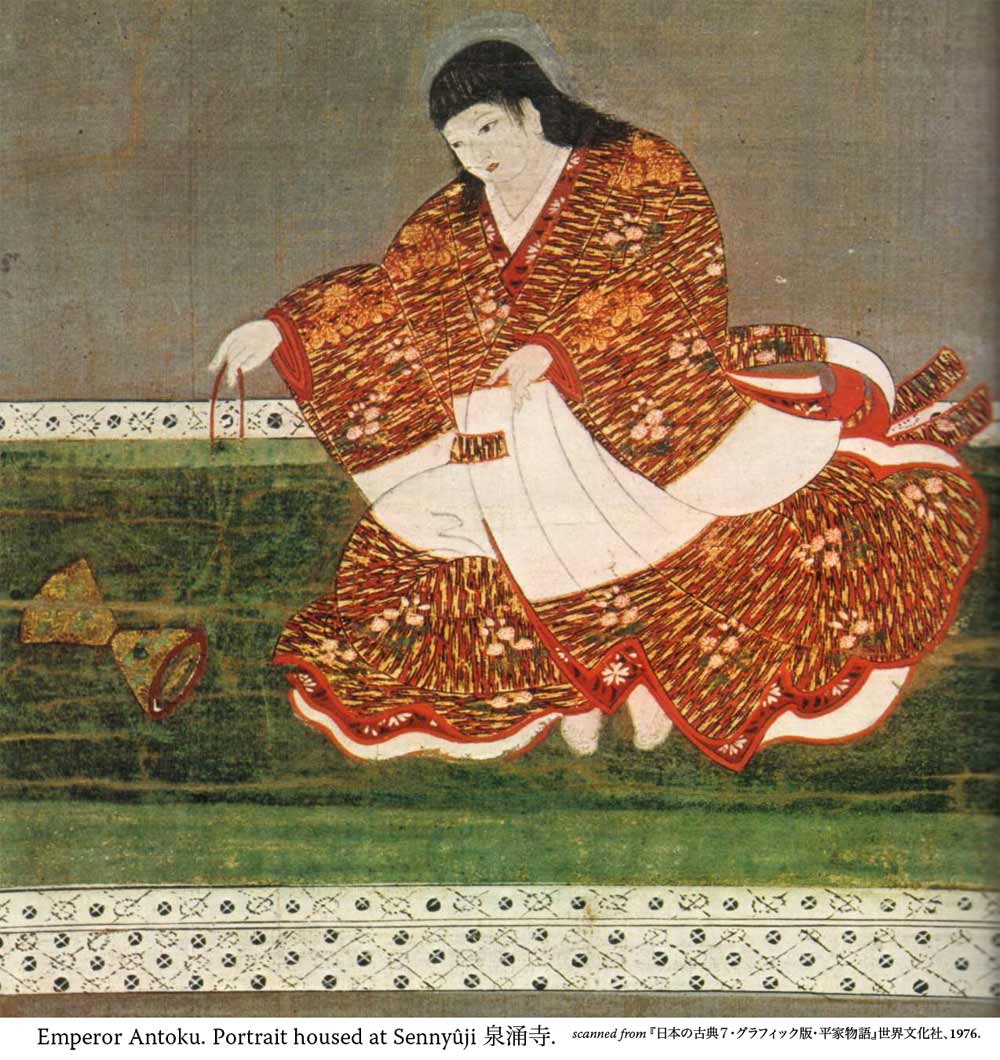
11-[10] The Death of Noritsune --- Kenreimon'in, seeing that her son Antoku has been drowned, also leaps overboard, but she is grabbed by her hair by a Minamoto and dragged from the water. Another imperial lady tried to jump into the sea grasping the trunk that held the divine imperial mirror. She also fails. The trunk is opened and for those who did so "darkness blinded their eyes instantly and blood gushed from their nostrils." The Taira leader Munemori and his son Kiyomune can't bring themselves to jump. Taira push them in, but, being strong swimmers, they survive. They are captured. (Thus they start a long series of dark days before they are eventually executed.) The section title comes from the death of a very strong Taira warrior named Noritsune who attempts to kill Yoshitsune. Yoshitsune jumps away rather than fight him. Noritsune takes a frightening stand on a boat: "he threw his sword and spear into the sea and discarded his helmet. Then he ripped off the skirt of his armor, leaving only the cuirass, and stood with flying hair and outstretched arms." Finally three Minamoto warriors attack. He kicks one away and drags the other two them into the sea with him. The battle at Dan-no-ura, indeed the entire Gempei war basically, is in its final moments at the end of this section.
Multimedia
Kenreimon'in attempts to commit suicide by drowning
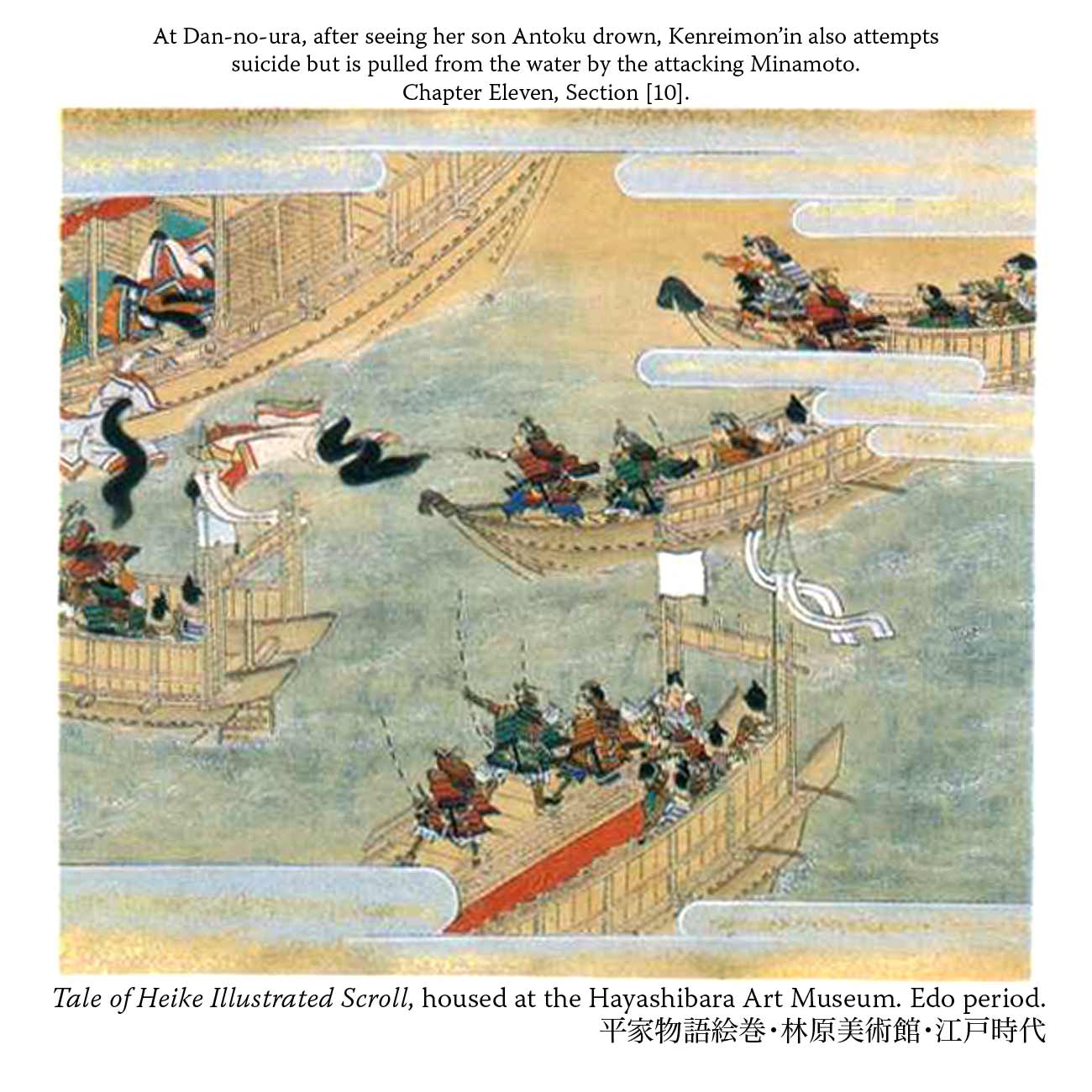
11-[11] The Sacred Mirror enters the Capital --- The battle at Dan-no-ura ends. Those who have been captured are listed. Two of the three seals of imperial power (the sword has been lost) are returned to Go-Shirakawa.
11-[12] Swords --- Discusses the background of the sacred swords belonging to the imperial family.
11-[13] The Parading of the Heike Along the Avenue --- The captured Taira are shown off in the Capital, a sad sight for all. Munemori is depicted as pitifully trying to protect his son Kiyomune.
Reading notes
- <387> "humble mean and women devoid of sensibility" --- The "humble" and the "devoid of sensibility" modify the noun "man" and the noun "woman" equally in the Japanese.
11-[14] The Mirror --- Yoritomo is promoted. Background of the sacred mirror is given. (For example, once it was able to jump of its own from the flames of a burning building).
11-[15] The Matter of the Letters --- Yoshitsune is sometimes called Hôgan or Kurô in this section. A box of letters that have come into Yoshitsune's possession is recovered by ruse and destroyed. We are never told why the contents might be dangerous. Trouble begins to brew between Yoritomo and Yoshitsune. The country, in general, is peaceful now that the Gempei war has ended.
11-[16] The Execution of Fukushô --- One of Munemori's young heirs is executed in the Capital, after saying good-bye to his father.
Character notes
- Fukushô is another name for Taira no Yoshimune, one of Munemori's two sons. As one of the sons of the Taira clan leader, he cannot be allowed to live. **This text calls him Nobumune, another possible reading for the characters of his name.
Reading notes
- <390> "Kantô" means the area of Kamakura where Yoritomo has set up government.
11-[17] Koshigoe --- Yoshitsune is sometimes called Hôgan or Kurô in this section, as well. Yoshitsune is transporting the leader of the Taira clan, Munemori, to Kamakura to hand over to Yoritomo. But before his arrival, Kagetoki slanders him. Yoritomo believes Kagetoki and does not allow Yoshitsune to enter Kamakura. He accepts Munemori at a check-point outside the city. Yoshitsune writes a long letter of complaint, outlining how faithfully he has served the country. Koshigoe is the place where Yoshitsune returns when he is refused entrance to Kamakura.
Character notes
- Ôe no Hiromoto. The man to whom Yoshitsune sends his long letter; he has been serving at a high level in the Kamakura military government since the previous year.
- Kagetoki. See this chapter, Section [1].
11-[18] The Execution of the Minister of State --- Yoshitsune's pledges of loyalty are not believed by his older brother Yoritomo. He is told to go back to the Capital (Kyoto, not the new government seat of Kamakura). He takes Taira leader Munemori and son with him. Munemori is executed, and then his son Kiyomune. Kiyomune is the braver of the two.
Multimedia
Munemori's son Kiyomune is executed
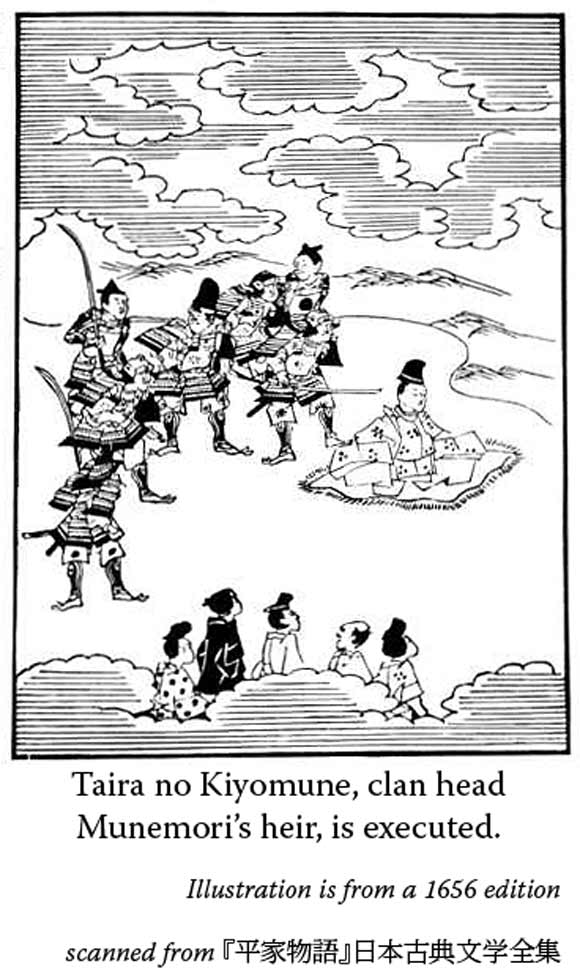
11-[19] The Execution of Shigehira --- Shigehira, who burned the Nara temples, is executed by the monks. He head is nailed at the spot where he directed that burning. It is later given to his wife Lady Dainagon-no-suke. I believe this is the same Dainagon-no-suke who unsuccessfully tried to jump into the sea with Kenreimon'in, clasping the trunk containing the sacred mirror. See this chapter, section [10]. **Some versions of this story treat this section as the first one of Chapter Twelve.
Multimedia
Shigehira is finally executed by the monks
